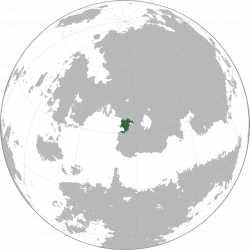Difference between revisions of "Archive:Shohuan"
Pittman789 (talk | contribs) |
Pittman789 (talk | contribs) |
||
| Line 115: | Line 115: | ||
|patron_saint = | |patron_saint = | ||
}} | }} | ||
'''Shohuan''' ( [[Shohuanese language|Shohuanese]]: {{cs|SPJ|Mosul}}), officially known as '''the Republic of Shohuan''' ( [[Shohuanese language|Shohuanese]]: {{cs|SPJ|Vwodî Mosul}}), is a country located in [[Vaniua|Western Vaniua]] and placed north of the [[Golden Plateau]]. It shares a northern border with [[Xonqorot]], and is bordered by both [[Ohania]] and [[Komania]] to the Southeast. With a population of over 74 million citizens and a GDP value over $2 Trillion USD, it is the leading economic center of Vaniua. | |||
According to linguists, Shohuan was settled by Vaniuan peoples around 1000 BCE, bringing both animal husbandry skills and agriculture. Around 500 CE, it was absorbed into the [[Holy Ohanian Empire]] when it adopted both [[Pauegism|Pauegist religion]] and its respective [[Vaniuan alphabet|alphabet]]. Shohuan itself was only formed from a small vassal state of the Ohanian Empire's northern border regions as a March in 904 CE, given the name ''Soppyu'' by the Ohanian Emperor. It later would see a rise to power around 1452 with its power base being firmly secured in the Northern Ohanian Empire when Shohuan itself was challenged by the Ohanian Emperor, defeating and effectively dissolving the Ohanian Empire's existing powers in 1617. Eventually, the nation would become a leading Colonial Power from 1837 to 1976, despite having a Sannist take-over in 1921 under the leadership of [[Wuetivort Saunat]] and its involvement in the [[Great Ekuosian War]] nearly two decades later. The Shohuanese state eventually dropped its Sannist leanings in 1976 under a new government that would be ruled under absolute majority following a nationwide protest. That government has since ruled the Shohuanese state with variations in leadership but an overall neutral policy. | |||
==History== | ==History== | ||
Revision as of 17:00, 16 July 2018
| The Republic of Shohuan Vwodon Mosulî |
||||||
|---|---|---|---|---|---|---|
|
||||||
| Motto: "Qûstsz, Hurz, jô þaggûv Dorn!" My struggle, my home, a United Realm! |
||||||
| Anthem: Joivl Dulvoi Song of the Peoples |
||||||
| Capital | Gvanieg | |||||
| Largest city | Jgulkeyon | |||||
| Official languages | Shohuanese | |||||
| Recognised national languages | Shohuanese | |||||
| Recognised regional languages | West Ohanian | |||||
| Ethnic groups | Shohuan (94 %) Other (6 %) |
|||||
| Demonym | Shohuanese | |||||
| Government | Republic | |||||
| - | Prince Elector of the Majority | Vbulos Kavdeto | ||||
| - | Prince Elector of the Minority | Movbat Jundisto | ||||
| Legislature | Congress of Shohuan | |||||
| Establishment | ||||||
| - | Arrival of Letsatians into Shohuan | 160 CE | ||||
| - | Rohe Dynasty | 234-874 CE | ||||
| - | Mankani Dynasty | 1024-1252 CE | ||||
| - | Shohuanese Revolution | October 3, 1773 | ||||
| - | Formation of the Second Republic | March 19, 1926 | ||||
| - | Revolution of 76 | June 16, 1976 | ||||
| Area | ||||||
| - | 261,334 km2 100,902 sq mi |
|||||
| Population | ||||||
| - | 2014 census | 27,178,736 | ||||
| - | Density | 104/km2 269.4/sq mi |
||||
| Gini | 48 high |
|||||
| HDI | 0.894 very high |
|||||
| Drives on the | right | |||||
| Internet TLD | .ni | |||||
Shohuan ( Shohuanese: Mosul), officially known as the Republic of Shohuan ( Shohuanese: Vwodî Mosul), is a country located in Western Vaniua and placed north of the Golden Plateau. It shares a northern border with Xonqorot, and is bordered by both Ohania and Komania to the Southeast. With a population of over 74 million citizens and a GDP value over $2 Trillion USD, it is the leading economic center of Vaniua.
According to linguists, Shohuan was settled by Vaniuan peoples around 1000 BCE, bringing both animal husbandry skills and agriculture. Around 500 CE, it was absorbed into the Holy Ohanian Empire when it adopted both Pauegist religion and its respective alphabet. Shohuan itself was only formed from a small vassal state of the Ohanian Empire's northern border regions as a March in 904 CE, given the name Soppyu by the Ohanian Emperor. It later would see a rise to power around 1452 with its power base being firmly secured in the Northern Ohanian Empire when Shohuan itself was challenged by the Ohanian Emperor, defeating and effectively dissolving the Ohanian Empire's existing powers in 1617. Eventually, the nation would become a leading Colonial Power from 1837 to 1976, despite having a Sannist take-over in 1921 under the leadership of Wuetivort Saunat and its involvement in the Great Ekuosian War nearly two decades later. The Shohuanese state eventually dropped its Sannist leanings in 1976 under a new government that would be ruled under absolute majority following a nationwide protest. That government has since ruled the Shohuanese state with variations in leadership but an overall neutral policy.


